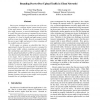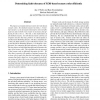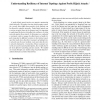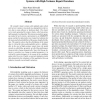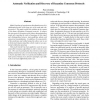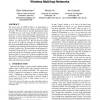DSN
2007
IEEE
14 years 3 months ago
2007
IEEE
Peer-to-peer technique has now become one of the major techniques to exchange digital content between peers of the same interest. However, as the amount of peer-topeer traffic inc...
DSN
2007
IEEE
14 years 3 months ago
2007
IEEE
Increasing interest is being paid to quantitative evaluation based on measurements of dependability attributes and metrics of computer systems and infrastructures. Despite measura...
DSN
2007
IEEE
14 years 3 months ago
2007
IEEE
Although there are various ways to exploit software vulnerabilities for malicious attacks, the attacks always result in unexpected behavior in program execution, deviating from wh...
DSN
2007
IEEE
14 years 3 months ago
2007
IEEE
This paper presents the design and implementation of a real-time behavior profiling system for high-speed Internet links. The profiling system uses flow-level information from con...
DSN
2007
IEEE
14 years 3 months ago
2007
IEEE
We propose a new fault tolerance metric for XOR-based erasure codes: the minimal erasures list (MEL). A minimal erasure is a set of erasures that leads to irrecoverable data loss ...
DSN
2007
IEEE
14 years 3 months ago
2007
IEEE
A prefix hijack attack involves an attacker announcing victim networks' IP prefixes into the global routing system. As a result, data traffic from portions of the Internet ca...
DSN
2007
IEEE
14 years 3 months ago
2007
IEEE
We consider cluster systems with multiple nodes where each server is prone to run tasks at a degraded level of service due to some software or hardware fault. The cluster serves t...
DSN
2007
IEEE
14 years 3 months ago
2007
IEEE
Model-checking of asynchronous distributed protocols is challenging because of the large size of the state and solution spaces. This paper tackles this problem in the context of l...
DSN
2007
IEEE
14 years 3 months ago
2007
IEEE
Continuous data protection, which logs every update to a file system, is an enabling technology to protect file systems against malicious attacks and/or user mistakes, because it ...
CONEXT
2007
ACM
14 years 3 months ago
2007
ACM
The recent work on COPE by Katti et al. demonstrates a practical application of network coding to wireless multihop networks. We note, however, that the opportunistic nature of CO...
